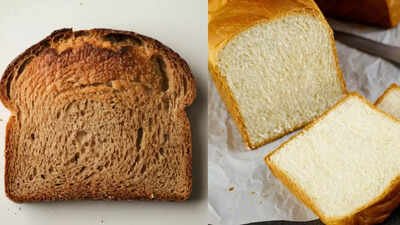Brown Bread vs. White Bread: Comparing fibre, blood sugar control, satiety, and heart health benefits |

Bread is one of the most common foods found in kitchens around the world, forming a key part of everyday meals from breakfast toast to lunchtime sandwiches. With so many varieties available, from classic white loaves to darker brown and wholegrain options, it’s easy to feel unsure about which type to choose. Different breads vary in texture, taste, and appearance, and people often have strong personal preferences. Some enjoy the soft, light nature of white bread, while others prefer the nutty flavour and dense texture of brown or wholemeal loaves. Understanding the differences between these types can help you make choices that suit your lifestyle and taste without feeling restricted.
Understanding the differences between white bread and brown bread
White breadWhite bread is made from refined wheat flour. During milling, the bran and germ are removed, leaving only the starchy endosperm. Although white bread in the UK is fortified with calcium, iron, and B vitamins, it lacks the naturally occurring fibre and micronutrients found in whole grains.
- Low in fibre
- Rapidly digested, with a higher glycaemic index (GI)
- Often fortified to replace lost vitamins and minerals
Brown breadBrown bread generally refers to wholemeal or wholegrain bread, made using the entire wheat grain, bran, germ, and endosperm. This preserves more nutrients, including fibre, vitamins, and minerals.
- Higher in dietary fibre, which supports digestion and satiety
- Slower to digest, helping maintain stable blood sugar
- Richer in vitamins and minerals naturally
- Not all brown bread is wholemeal; check the label to ensure quality
Comparing the health benefits and considerations of white bread and brown bread
Blood sugar and metabolic healthWhite bread has a high GI, leading to rapid blood sugar spikes and energy crashes. Frequent consumption may impact insulin sensitivity and increase hunger, particularly for those managing diabetes. Brown bread, especially wholemeal or wholegrain, has a lower GI. Fibre slows carbohydrate absorption, providing a steady energy release, reducing sugar spikes, and supporting long-term metabolic health. This slower digestion also helps curb cravings and supports satiety. According to a study published in the British Journal of Nutrition, intake of whole‑grain foods significantly reduced post‑prandial glucose and insulin responses compared with refined‑grain foods. Digestive healthBrown bread’s fibre promotes digestive health by adding bulk to stools and feeding beneficial gut bacteria. Regular consumption can help prevent constipation and support a healthy microbiome. According to a study published in The Journal of Nutrition, participants who consumed whole‑grain rye bread (rather than white wheat bread) experienced a 23% shorter intestinal transit time, roughly 1.4 more weekly bowel movements, and softer stools, demonstrating improved digestive function. White bread, with its low fibre content, offers limited support for gut health. Diets high in refined flour may increase the risk of constipation and other digestive issues over time, fibre from whole grains helps maintain intestinal homeostasis by increasing stool weight and promoting regularity.Heart healthWholegrain brown bread supports cardiovascular health. Its fibre can lower LDL (“bad”) cholesterol, while antioxidants and phytonutrients reduce inflammation and maintain healthy blood vessels. Studies indicate regular wholegrain consumption can reduce the risk of heart disease, stroke, and hypertension.White bread lacks many of these protective nutrients. Although fortified, it does not provide the same heart-protective benefits as wholemeal bread.Satiety and weight managementBrown bread promotes longer-lasting fullness due to its fibre content, which can help manage appetite, reduce snacking, and support weight control.White bread is digested quickly, often leaving you hungry sooner, which can lead to increased snacking and higher calorie intake. Pairing white bread with protein or fibre-rich foods can help counteract this effect.
Disclaimer: This article is for informational purposes only and should not be considered medical advice. Please consult a healthcare professional before making any changes to your diet, medication, or lifestyle.
var _mfq = window._mfq || [];
_mfq.push([“setVariable”, “toi_titan”, window.location.href]);
!(function(f, b, e, v, n, t, s) {
function loadFBEvents(isFBCampaignActive) {
if (!isFBCampaignActive) {
return;
}
(function(f, b, e, v, n, t, s) {
if (f.fbq) return;
n = f.fbq = function() {
n.callMethod ? n.callMethod(…arguments) : n.queue.push(arguments);
};
if (!f._fbq) f._fbq = n;
n.push = n;
n.loaded = !0;
n.version = ‘2.0’;
n.queue = [];
t = b.createElement(e);
t.async = !0;
t.defer = !0;
t.src = v;
s = b.getElementsByTagName(e)[0];
s.parentNode.insertBefore(t, s);
})(f, b, e, ‘https://connect.facebook.net/en_US/fbevents.js’, n, t, s);
fbq(‘init’, ‘593671331875494’);
fbq(‘track’, ‘PageView’);
};
function loadGtagEvents(isGoogleCampaignActive) {
if (!isGoogleCampaignActive) {
return;
}
var id = document.getElementById(‘toi-plus-google-campaign’);
if (id) {
return;
}
(function(f, b, e, v, n, t, s) {
t = b.createElement(e);
t.async = !0;
t.defer = !0;
t.src = v;
t.id = ‘toi-plus-google-campaign’;
s = b.getElementsByTagName(e)[0];
s.parentNode.insertBefore(t, s);
})(f, b, e, ‘https://www.googletagmanager.com/gtag/js?id=AW-877820074’, n, t, s);
};
function loadSurvicateJs(allowedSurvicateSections = []){
const section = window.location.pathname.split(‘/’)[1]
const isHomePageAllowed = window.location.pathname === ‘/’ && allowedSurvicateSections.includes(‘homepage’)
const ifAllowedOnAllPages = allowedSurvicateSections && allowedSurvicateSections.includes(‘all’);
if(allowedSurvicateSections.includes(section) || isHomePageAllowed || ifAllowedOnAllPages){
(function(w) {
function setAttributes() {
var prime_user_status = window.isPrime ? ‘paid’ : ‘free’ ;
var geoLocation = window?.geoinfo?.CountryCode ? window?.geoinfo?.CountryCode : ‘IN’ ;
w._sva.setVisitorTraits({
toi_user_subscription_status : prime_user_status,
toi_user_geolocation : geoLocation
});
}
if (w._sva && w._sva.setVisitorTraits) {
setAttributes();
} else {
w.addEventListener(“SurvicateReady”, setAttributes);
}
var s = document.createElement(‘script’);
s.src=”https://survey.survicate.com/workspaces/0be6ae9845d14a7c8ff08a7a00bd9b21/web_surveys.js”;
s.async = true;
var e = document.getElementsByTagName(‘script’)[0];
e.parentNode.insertBefore(s, e);
})(window);
}
}
window.TimesApps = window.TimesApps || {};
var TimesApps = window.TimesApps;
TimesApps.toiPlusEvents = function(config) {
var isConfigAvailable = “toiplus_site_settings” in f && “isFBCampaignActive” in f.toiplus_site_settings && “isGoogleCampaignActive” in f.toiplus_site_settings;
var isPrimeUser = window.isPrime;
var isPrimeUserLayout = window.isPrimeUserLayout;
if (isConfigAvailable && !isPrimeUser) {
loadGtagEvents(f.toiplus_site_settings.isGoogleCampaignActive);
loadFBEvents(f.toiplus_site_settings.isFBCampaignActive);
loadSurvicateJs(f.toiplus_site_settings.allowedSurvicateSections);
} else {
var JarvisUrl=”https://jarvis.indiatimes.com/v1/feeds/toi_plus/site_settings/643526e21443833f0c454615?db_env=published”;
window.getFromClient(JarvisUrl, function(config){
if (config) {
const allowedSectionSuricate = (isPrimeUserLayout) ? config?.allowedSurvicatePrimeSections : config?.allowedSurvicateSections
loadGtagEvents(config?.isGoogleCampaignActive);
loadFBEvents(config?.isFBCampaignActive);
loadSurvicateJs(allowedSectionSuricate);
}
})
}
};
})(
window,
document,
‘script’,
);
Source link



